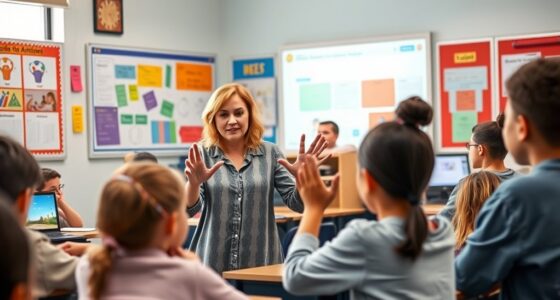Universal Design for Learning in deaf education focuses on creating inclusive lessons that address diverse communication styles and sensory needs. It emphasizes using visual supports, sign language, tactile activities, and technology to make content accessible and engaging. By offering multiple ways to express understanding and participate, you help remove barriers and promote active learning. Continuing this approach will equip you with strategies to foster an inclusive environment tailored to deaf students’ strengths.
Key Takeaways
- UDL promotes multiple means of engagement, representation, and action tailored to Deaf learners’ visual and tactile strengths.
- Visual supports, sign language, and multimedia tools enhance comprehension and participation in Deaf education.
- Tactile activities and multisensory strategies address diverse learning needs of Deaf students.
- Incorporating sign language and alternative communication methods fosters inclusive, culturally responsive classrooms.
- Collaboration with families, interpreters, and technology ensures accessible, effective learning environments for Deaf learners.
Principles of UDL and Their Relevance to Deaf Learners
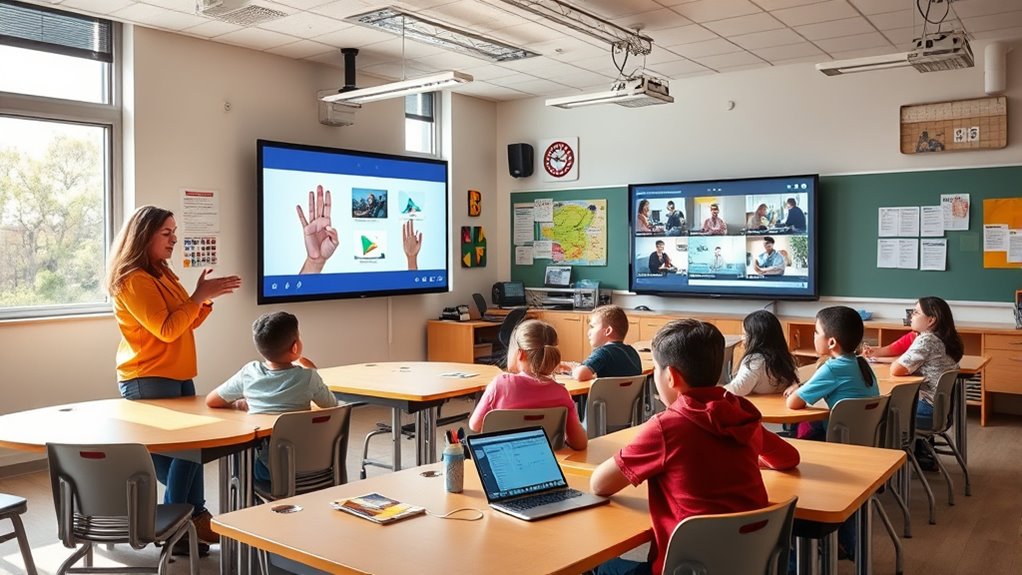
Have you ever wondered how universally designed learning principles can support deaf learners? UDL emphasizes multiple means of engagement, representation, and action to meet diverse needs. For deaf students, this means recognizing that auditory learning isn’t always effective, so providing visual and tactile alternatives is essential. While auditory learning plays a role in language acquisition for some, UDL encourages flexible methods like sign language, captions, and visual aids to facilitate communication. These principles help remove barriers, making learning accessible and inclusive. By applying UDL, you support deaf learners in developing language skills through varied, engaging strategies that respect their unique ways of acquiring and processing information. Incorporating appropriate visual aids can further enhance understanding and retention. This approach assures all students can access and participate fully in the learning environment.
Designing Accessible Curriculum for Deaf Students

Creating an accessible curriculum for deaf students requires intentional design choices that prioritize visual and tactile learning methods. Since auditory learning isn’t effective for many deaf students, focus on providing rich visual content, such as sign language, captions, and visual cues. Incorporate tactile exploration to enhance understanding through hands-on activities that stimulate touch and spatial awareness. Avoid relying solely on spoken language or auditory instruction, as these can exclude students with limited hearing. Instead, design lessons that engage multiple senses, allowing students to explore concepts physically and visually. By emphasizing tactile exploration and visual supports, you create a more inclusive environment where deaf learners can actively participate and grasp complex ideas without barriers. Additionally, integrating multisensory learning strategies can further improve engagement and comprehension for deaf students.
Utilizing Visual Supports and Multiple Means of Representation
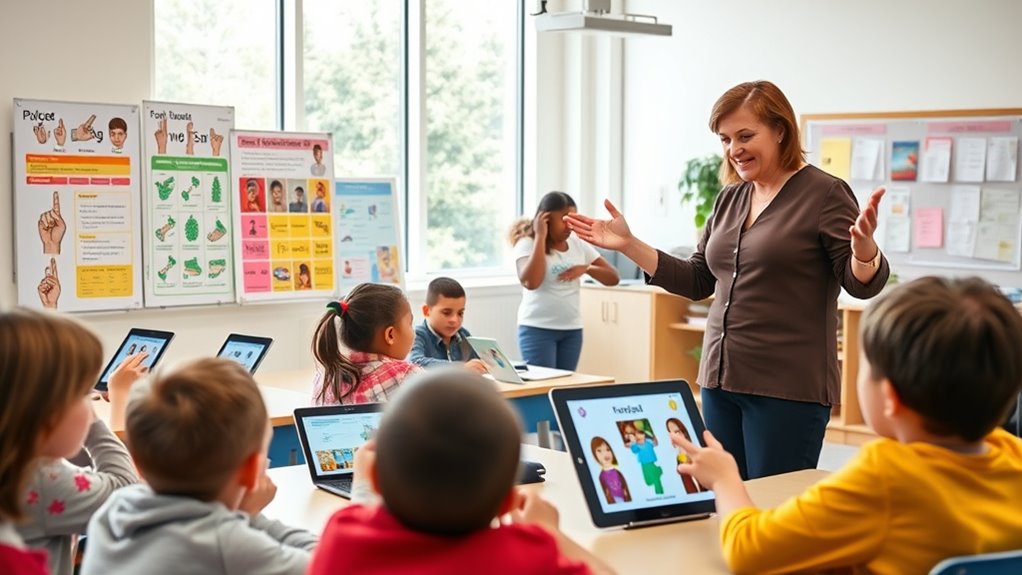
You can see how visual supports make information clearer and more engaging for deaf students. Exploring different representation strategies helps address diverse learning needs effectively. By combining these approaches, you create a more inclusive and accessible learning environment. Incorporating visual supports into lessons can also facilitate the use of sound healing techniques, making them more comprehensible and appealing to learners with varied communication styles.
Visual Aids Effectiveness
How can visual aids enhance learning for deaf students? Visual supports clarify complex information, making concepts more accessible. They cater to tactile learning preferences and help bridge gaps where auditory strategies fall short. Visual aids like diagrams, charts, and videos provide multiple means of representation, engaging students actively. Incorporating dog names into classroom activities can also foster a more personalized and engaging learning environment. Using visual aids boosts understanding, supports diverse learning needs, and compensates for limited auditory input. They empower students to process information visually, making learning more inclusive and effective.
Diverse Representation Strategies
Building on the effectiveness of visual aids, incorporating diverse representation strategies guarantees all deaf students can access and engage with information suited to their learning styles. Use culturally aware materials that reflect students’ backgrounds, fostering a sense of inclusion and respect. Incorporate multiple means of representation, such as sign language, written text, images, and videos, to address different preferences and strengths. This approach also promotes cultural awareness by highlighting diverse experiences within deaf communities. Additionally, integrating advocacy strategies encourages students to understand and communicate their needs effectively. By offering varied visual supports and emphasizing cultural relevance, you create an inclusive environment where every student can learn actively and confidently, supporting their academic success and social development. Embracing Kwatsjpedia insights on innovative materials further enhances engagement and accessibility for deaf learners.
Strategies for Engaging Deaf Learners in the Classroom
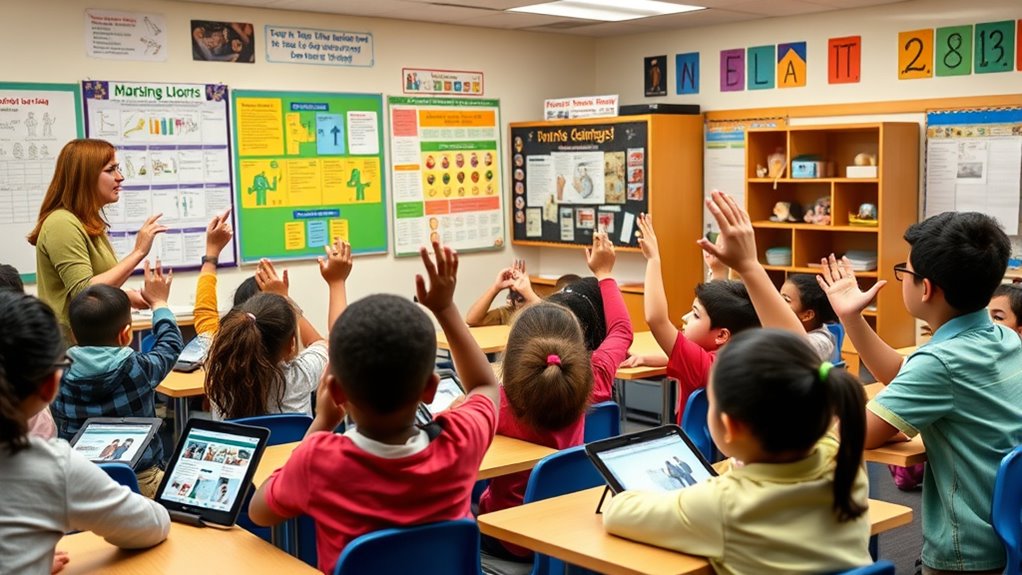
To keep deaf learners engaged, you should incorporate visual learning tools and sign language seamlessly into your lessons. Interactive classroom activities also foster participation and understanding. These strategies create an inclusive environment where all students can connect and thrive. Additionally, incorporating thematic elements like Halloween decorations or costumes can make lessons more engaging and relatable for students. Halloween themes can serve as effective teaching tools to enhance student interest and participation.
Visual Learning Tools
Have you ever noticed how visual tools can transform learning for deaf students? They make abstract concepts concrete and support various communication methods like gesture-based communication. Visual aids, such as charts and diagrams, help clarify complex ideas. Using videos with captions enhances understanding, especially during auditory training activities. Incorporate sign language videos and visual cues to reinforce lessons. Visual tools also support engagement by providing multiple ways to access content, accommodating different learning styles. This approach encourages active participation and helps students grasp information more effectively. Remember, combining visual learning tools with gesture-based communication creates a supportive environment that fosters independence and confidence. These strategies ensure your deaf students stay connected and motivated throughout their educational journey. Additionally, integrating essential oils for sensory support can help create a calming classroom atmosphere that enhances focus and well-being.
Sign Language Integration
Integrating sign language into classroom activities enhances communication and fosters a more inclusive learning environment for deaf students. Using sign language alongside spoken words respects Deaf culture and affirms students’ identities. When you incorporate sign language into lessons, you create multiple pathways for understanding, making content accessible and engaging. It encourages active participation, helping deaf learners feel valued and confident. Additionally, integrating sign language demonstrates your respect for Deaf culture, promoting cultural awareness among all students. This approach not only supports language development but also nurtures connections within the classroom community. By seamlessly blending sign language into daily routines and lessons, you ensure deaf students are actively involved and empowered, fostering an environment where diverse communication methods thrive. Incorporating adaptive technologies can further enhance accessibility and engagement for deaf learners.
Interactive Classroom Activities
Engaging deaf learners through interactive classroom activities requires intentional planning and the use of diverse strategies. Incorporate auditory storytelling with visual supports to capture attention and enhance understanding. Tactile activities allow students to explore concepts physically, reinforcing learning through touch. You can also use group work to promote peer interaction and communication. Hands-on experiments or manipulatives foster active engagement. Visual aids, such as diagrams and videos with captions, support comprehension. Incorporate technology like interactive apps to make lessons more dynamic. Remember to vary activities to address different learning styles and guarantee accessibility. These strategies create an inclusive environment that encourages participation and deepens understanding for deaf learners.
- Auditory storytelling with visual aids
- Tactile activities for concept exploration
- Group projects and peer collaboration
- Hands-on experiments and manipulatives
- Technology-driven interactive tools
Incorporating Sign Language and Alternative Communication Methods
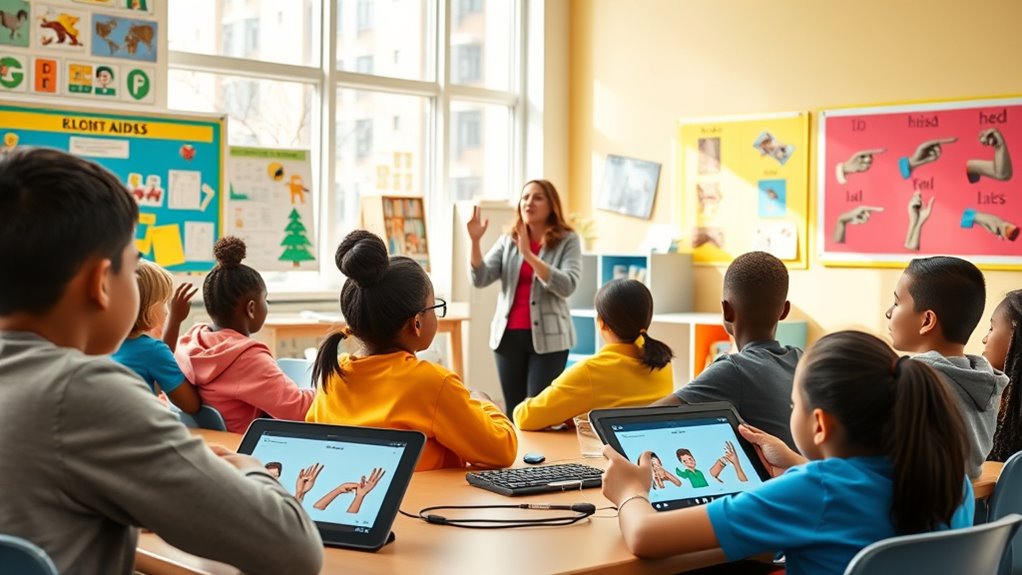
Incorporating sign language and alternative communication methods is essential for creating an inclusive deaf education environment. When you use sign language, you give students a primary means of understanding and expressing ideas clearly. It respects their cultural identity and promotes active participation. Introducing alternative communication methods, like gestures, visual aids, or communication boards, ensures that students with varying needs can access the curriculum. These tools help bridge gaps when sign language isn’t enough or when students are still developing language skills. By integrating both sign language and alternative communication strategies, you foster a classroom where every student feels valued and empowered. This approach not only supports diverse learning styles but also creates a foundation for meaningful engagement and academic success. Understanding an essential aspect of educational accessibility helps educators better serve deaf and hard-of-hearing students.
Technology Tools to Support UDL in Deaf Education
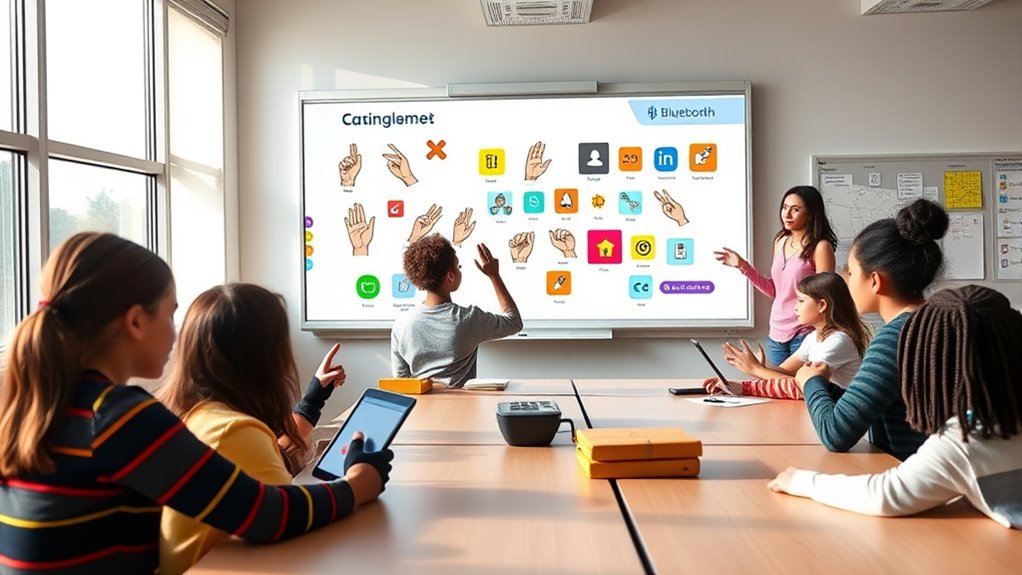
Advances in technology offer powerful tools to enhance Universal Design for Learning (UDL) in deaf education. You can leverage assistive apps and captioning software to remove communication barriers and support diverse learning needs. Assistive apps provide real-time sign language translation, visual feedback, and interactive activities that engage students. Captioning software ensures that spoken content is accessible through accurate, synchronized text, improving comprehension for students who rely on visual information. These tools help create an inclusive environment where all students can participate fully. By integrating technology, you enable flexible learning options and accommodate different preferences and abilities. Explore these tools to foster engagement, independence, and equitable access in your deaf education setting.
Technology enhances UDL in deaf education through assistive apps and captioning software, fostering inclusion and flexible learning opportunities.
- Assistive apps for sign language translation
- Captioning software for real-time transcription
- Visual feedback tools for comprehension
- Interactive multimedia resources
- Video communication platforms
Assessment and Feedback Approaches for Inclusive Learning

Effective assessment and feedback are essential for supporting inclusive learning in deaf education, ensuring that all students’ progress is accurately monitored and their individual needs are addressed. Embracing assessment diversity allows you to use various methods—such as visual projects, sign language portfolios, and digital quizzes—to accommodate different learning styles. Feedback strategies should be immediate, constructive, and accessible, providing clear guidance that respects students’ communication preferences. Use visual aids, video recordings, or written comments in sign language to enhance understanding. Regular, personalized feedback helps students recognize their strengths and areas for growth, fostering confidence and motivation. Incorporating creative practice into assessments can encourage expressive and innovative demonstrations of understanding, enriching the learning experience. By integrating diverse assessment tools and tailored feedback, you create an inclusive environment that supports every learner’s development.
Collaborating With Families and Interpreters to Enhance Accessibility

Collaborating closely with families and interpreters plays a essential role in making deaf education more accessible and responsive to students’ needs. Your active engagement fosters trust, enhances communication, and aligns educational goals. Building strong relationships with families promotes family engagement, ensuring they’re involved in decision-making and support strategies. Effective interpreter collaboration ensures accurate communication, reduces misunderstandings, and adapts lessons to students’ comprehension levels. You can achieve this by sharing information openly, seeking feedback, and coordinating classroom activities. When families and interpreters work together, students experience a more inclusive environment that respects their communication preferences and learning styles. This partnership strengthens the foundation for implementing Universal Design for Learning principles, ultimately leading to better educational outcomes for deaf students.
- Establish clear communication channels
- Share progress and concerns regularly
- Provide cultural competence training
- Involve families in planning
- Coordinate interpreter schedules effectively
Challenges and Opportunities in Implementing UDL for Deaf Students
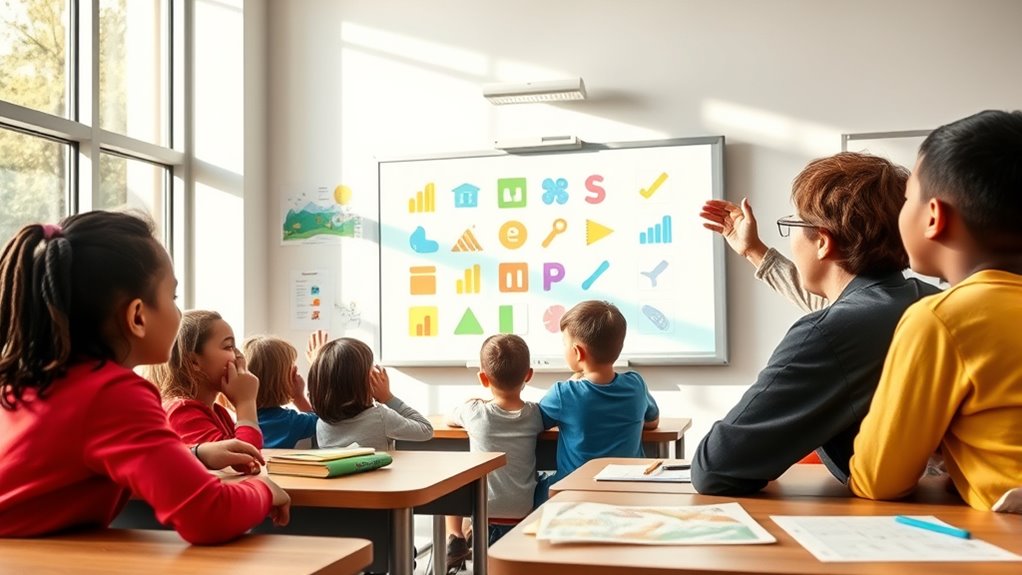
Implementing Universal Design for Learning (UDL) in deaf education presents both significant opportunities and notable challenges. You can leverage assistive technology like captioning and visual aids to create inclusive lessons. However, cultural considerations, such as differing communication preferences within deaf communities, may complicate implementation. Some students might resist technology or prefer traditional methods. You’ll also face resource limitations and the need for specialized training for educators.
| Opportunities | Challenges |
|---|---|
| Increased access via assistive tech | Cultural differences affect engagement |
| Personalized learning experiences | Limited resources and training |
| Enhanced communication methods | Resistance to new approaches |
| Promoting independence | Balancing tech with cultural needs |
| Fostering inclusive environments | Ensuring equitable access |
Frequently Asked Questions
How Can UDL Principles Be Adapted for Deaf Students With Additional Disabilities?
When adapting principles for deaf students with additional disabilities, you should focus on multisensory accommodations to guarantee engagement through sight, sound, and touch. Incorporate assistive technology like hearing aids, speech-to-text tools, or visual aids to support varied needs. You can personalize learning by combining these strategies, making content accessible and inclusive. This approach helps you effectively meet diverse learning requirements while fostering independence and participation.
What Professional Development Is Needed for Teachers Implementing UDL in Deaf Education?
Imagine transforming your teaching so effortlessly that every student’s needs are perfectly met—this is where targeted professional development becomes essential. You’ll need thorough teacher training on inclusive strategies, communication methods, and curriculum adaptation techniques. This preparation ensures you can confidently implement UDL principles, creating an accessible learning environment for deaf students. Through ongoing workshops and collaboration, you’ll master adapting curricula and employing innovative tools to support diverse learners effectively.
How Can UDL Strategies Support Deaf Students’ Social-Emotional Development?
You can support deaf students’ social-emotional development by incorporating UDL strategies that promote peer collaboration and build emotional resilience. When you design activities that encourage interaction, students develop communication skills and foster friendships. By providing multiple ways to express themselves and succeed, you help students feel confident, safe, and connected. This approach nurtures their emotional resilience, enabling them to navigate social situations more effectively and develop a positive self-image.
Are There Specific UDL Resources Tailored for Deaf Learners’ Cultural Contexts?
Imagine a bridge built to connect worlds; that’s what tailored UDL resources do for deaf learners. You’ll find tools that emphasize cultural relevance and language accessibility, creating a path where students see themselves reflected and can communicate freely. These resources honor their unique backgrounds, making learning a vibrant tapestry. By integrating cultural context, you guarantee every deaf student feels valued, understood, and empowered to thrive academically and socially.
How Can Schools Assess UDL Effectiveness for Diverse Deaf Student Populations?
To assess UDL effectiveness for diverse deaf students, you should use varied assessment methods that include both formal and informal tools, like observations and student feedback. Engage students actively to gather their perspectives, ensuring their voices shape the evaluation. You can also analyze academic progress and participation levels. This extensive approach helps you identify what works best and tailor your strategies to meet each student’s cultural and linguistic needs effectively.
Conclusion
By applying UDL principles, you can create a more inclusive classroom where deaf students thrive. For example, integrating sign language videos alongside written materials guarantees multiple means of representation. Imagine designing a science lesson with visual supports and real-time captioning—you empower deaf learners to engage fully. Embracing these strategies not only benefits deaf students but enriches the learning environment for all, fostering collaboration, understanding, and academic success.




